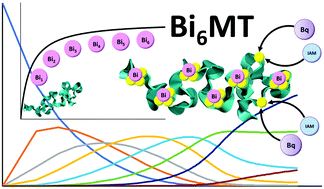pH dependence of the non-cooperative binding of Bi3+ to human apo-metallothionein 1A: kinetics, speciation, and stoichiometry
Abstract
Bismuth is a well-known therapeutic agent that is used primarily for treatment against peptic ulcers. It has also had success in protecting against nephrotoxicity caused by the anticancer compound cisplatin by inducing the liver and kidney metalloprotein, metallothionein (MT) that then binds to the cisplatin. MT is a small, ubiquitous protein that binds monovalent, divalent, and trivalent metals using its abundant cysteine thiols (20 cysteines in the mammalian protein). It is important in the understanding of both these therapeutic applications to explore in detail the earliest stages of MT binding to bismuth salts. In this paper, we explored the binding of [Bi(cit)]− and [Bi(EDTA)]− to apo-MT 1a as the most basic of binding motifs. It was found that both Bi3+ salts bound in a non-cooperative stepwise manner to terminal cysteinal thiolates at pH 2.6, 5.0, and 7.4. We report that [Bi(EDTA)]− only binds stepwise up to Bi6MT, whereas [Bi(cit)]− forms up to Bi8MT, where the 7th and 8th Bi3+ appear to be adducts. Stepwise speciation analysis provided the 7 binding constants that decreased systematically from K1 to K7 indicating a non-cooperative binding profile. They are reported as log K1 = 27.89, log K2 = 27.78, log K3 = 27.77, log K4 = 27.62, log K5 = 27.32, log K6 = 26.75, and log K7 = 26.12, with log K[Bi(cit)]− determined to be 24.17. Cysteine modifications with benzoquinone and iodoacetamide revealed that when apoMT is fully metallated with Bi3+ there are two free cysteines, meaning 18 cysteines are used in binding the 6 Bi3+. Kinetic studies showed that [Bi(EDTA)]− binds very slowly at pH 2.6 (k = 0.0290 × 106 M−1 s−1) and approximately 2000 times faster at pH 7.4 (k = 66.5 × 106 M−1 s−1). [Bi(cit)]− binding at pH 2.6 was faster than [Bi(EDTA)]− (k = 672 × 106 M−1 s−1) at either pH level. The data strongly support a non-clustered binding motif, emphasizing the non-traditional pathway reported previously for As3+.



 Please wait while we load your content...
Please wait while we load your content...